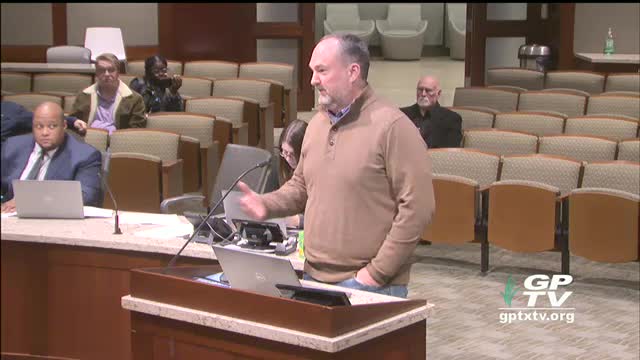Fort Worth residents clash over property lines and safety concerns at city council meeting
January 22, 2025 | Grand Prairie, Dallas County, Texas
This article was created by AI summarizing key points discussed. AI makes mistakes, so for full details and context, please refer to the video of the full meeting. Please report any errors so we can fix them. Report an error »

During the recent Grand Prairie Zoning Board of Adjustment meeting held on January 22, 2025, significant discussions emerged regarding a proposed zoning application that has sparked both support and opposition from community members. The meeting highlighted concerns about property boundaries, safety issues, and the historical significance of the land in question.
One of the primary topics addressed was the potential liability and safety risks associated with the proposed development. Nathan Percinski, representing Polymerica, emphasized the city's responsibility to manage safety concerns, particularly regarding individuals fishing in nearby ponds. He noted that the city could face liability issues if someone were to get injured, underscoring the need for clear regulations to prevent trespassing and ensure public safety.
Conversely, opposition to the proposal was voiced by Edward Hempel, a former chairman of the board, who raised concerns about unclear property lines. Hempel argued that the proposal could infringe upon neighboring properties, including his own, and called for a thorough review of property ownership before any decisions are made. He highlighted the historical significance of the land, noting that it was once owned by L.T. Dave, Texas's first black millionaire, and served as a buffer for the community.
Hempel's remarks reflect a broader sentiment among some community members who are wary of developments that could disrupt the historical and cultural fabric of the area. He expressed a willingness to collaborate with Polymerica but insisted that clarity on property boundaries is essential before proceeding with any votes on the application.
The meeting concluded without a definitive resolution, leaving the board to consider the implications of the discussions. As the community grapples with the balance between development and preservation, the outcome of this zoning application will likely have lasting effects on the neighborhood's character and safety. The board is expected to revisit the proposal in future sessions, with community input remaining a critical component of the decision-making process.
One of the primary topics addressed was the potential liability and safety risks associated with the proposed development. Nathan Percinski, representing Polymerica, emphasized the city's responsibility to manage safety concerns, particularly regarding individuals fishing in nearby ponds. He noted that the city could face liability issues if someone were to get injured, underscoring the need for clear regulations to prevent trespassing and ensure public safety.
Conversely, opposition to the proposal was voiced by Edward Hempel, a former chairman of the board, who raised concerns about unclear property lines. Hempel argued that the proposal could infringe upon neighboring properties, including his own, and called for a thorough review of property ownership before any decisions are made. He highlighted the historical significance of the land, noting that it was once owned by L.T. Dave, Texas's first black millionaire, and served as a buffer for the community.
Hempel's remarks reflect a broader sentiment among some community members who are wary of developments that could disrupt the historical and cultural fabric of the area. He expressed a willingness to collaborate with Polymerica but insisted that clarity on property boundaries is essential before proceeding with any votes on the application.
The meeting concluded without a definitive resolution, leaving the board to consider the implications of the discussions. As the community grapples with the balance between development and preservation, the outcome of this zoning application will likely have lasting effects on the neighborhood's character and safety. The board is expected to revisit the proposal in future sessions, with community input remaining a critical component of the decision-making process.
View full meeting
This article is based on a recent meeting—watch the full video and explore the complete transcript for deeper insights into the discussion.
View full meeting
